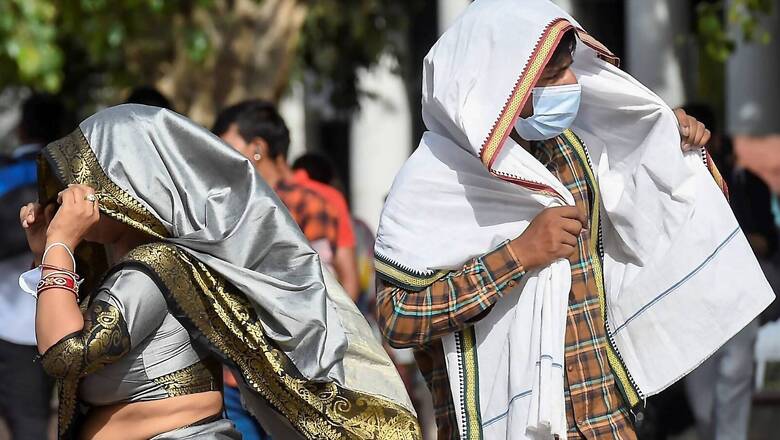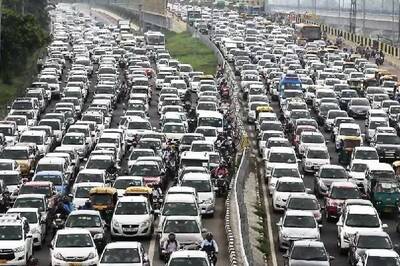
views
India is witnessing an unprecedented heatwave. The mercury touched 50 degrees Celsius last Sunday in parts of Delhi and Uttar Pradesh. Similarly, Mumbai is facing an unexpected surge in heat. These incidents clearly point at the climate crisis in India. To deal with this crisis, it is essential to go back to basics. In India, the discussion on air pollution, which is one of the most critical factors behind climate change, is restricted to the National Capital Region, and particularly Delhi. The need of the hour is to bring together all the states and formulate a comprehensive year-round plan along with achievable targets to combat pollution.
Relationship between Heatwave and Climate Change
The MET department of the United Kingdom has published a study on the ongoing heatwave in India. The study findings suggest that climate change caused by human beings is one of the most significant causes of this heatwave. A report on the study noted, “The study shows that the natural probability of a heatwave exceeding the average temperature in 2010 is once in 312 years. In the current climate – accounting for climate change – the probabilities increase to once in every 3.1 years. And by the end of the century, the study – incorporating climate change projections – shows this will increase to once every 1.15 years.”
The Intergovernmental Panel on Climate Change (IPCC) report published by the United Nations last year observed, “Human influence has warmed the climate at a rate that is unprecedented in at least the last 2,000 years. In 2019, atmospheric CO2 concentrations were higher than at any time in at least 2 million years, and concentrations of methane and nitrous oxide were higher than at any time in the last 800,000 years.”
ALSO READ | How Indian Policymakers and Citizens Should Read IPCC Report’s Code Red for Humanity
Effect of Pollution on Climate Change
From these two reports, some points stand out. First, human influence on climate change is a crucial reason behind the climate crisis. Second, while climate change raises temperatures and makes heatwaves hotter, it also affects the pattern of changing weather.
Air pollution and climate change are not different issues at all. Global research on climate change has repeatedly pointed out the correlation between the two. The United Nations Environment Programe (UNEP) notes, “Although they may seem to be two very different issues, climate change and air pollution are closely interlinked, so by reducing air pollution we also protect the climate. Air pollutants include more than just greenhouse gases — principally carbon dioxide but also methane, nitrous oxide, and others — but there’s a big overlap: the two often interact with each other.”
Air pollution is majorly human-induced in India. Some of the reasons behind the uncontrolled air pollution in India are haphazard urban planning, rampant open burning, faulty waste management systems, landfills, too much dependency on coal power, unchecked industry emissions, and so on.
Pollution is a Pan India Issue
The discussions and policies regarding air pollution are concentrated in the National Capital Region (NCR) and Delhi. But this is not enough. According to a study published by the Centre for Science and Environment (CSE), 56 North Indian cities show winter pollution trends similar to Delhi. “Even smaller cities with lower annual average levels record pollution levels that are as bad or even worse than Delhi,” Anumita Roychowdhury, the co-author of the study, told Down to Earth. Cities like Vrindavan, Agra, and Firozabad (all in UP), the study shows, have comparatively lower annual average particulate matter 2.5 (PM2.5) levels than Delhi but in winter (2021) their weekly average PM2.5 levels were more than Delhi’s.
The pollution problem, however, is not restricted to North India anymore. For example, the problem of air pollution in Mumbai has only worsened in the past decade. PM10 is the highest in Mumbai among the 24 major cities in peninsular India. Among the three major coastal cities (Kolkata, Chennai and Mumbai), the particulate concentration in Mumbai has increased exponentially over the last few years. Similarly, an analysis by the Centre for Science and Environment (CSE) showed that PM 2.5 levels in Kolkata’s air last year exceeded the national standard by more than 1.5 times and by more than 13 times the standard set by the World Health Organisation (WHO).
What States Must Do to Combat Air Pollution
It is important for each state to come forward and formulate its own action plans. Many states, in the past, have failed to present their action plans to the National Green Tribunal. As part of the action plan, air monitoring networks should be strengthened and electric vehicles should be adopted to reduce transportation-related pollution. Regulation compliance should be strengthened, and industrial emissions should be better controlled.
India has a National Clean Air Programme (NCAP) and the states have an important role in this plan. State governments can legally compel cities and districts to meet their goals. If this is not done within a specified amount of time, it could be linked to the disbursement of development funds, for instance.
It is high time for each state to have adequate number of real-time pollution monitoring stations across cities. There is also a need to identify pollution hotspots in each state. There are no central directives on these issues, which has been affecting the overall initiatives against climate change. Furthermore, state-specific action plans must have comprehensive and effective monitoring systems, which are not only scalable but should also comply with sound reporting methodologies for analysing trends and taking useful policy actions.
Need For Sustainable, Long-term Action Plan
India now needs a sustainable and long-term action plan against climate change. When it comes to pollution, the whole focus is on the NCAP. But there is a need for decentralisation of this plan too. Freedom must be given to states to make their own targets, but with utmost accountability.
Last year, Prime Minister Narendra Modi presented India’s vision and climate targets at the 26th Conference of the Parties (CoP26) in Glasgow. The plan is named Panchamitra. One of the major highlights of this plan is that India will get its non-fossil energy capacity to 500 gigawatts by 2030. But in the current context of the heatwave and climate change warnings, there is a growing belief among experts that rather than tough targets, India must look at more achievable and sustainable targets while pursuing these long-term plans.
Similarly, initiatives to combat pollution and climate change should go hand in hand. The NCAP is a plan that came into effect before the COVID-19 pandemic. This disaster has changed India and the world economically. Therefore, rather than long-term plans, experts believe that year-round plans for combating pollution would be more effective. The yearly targets would be easy to achieve and budget allocations would be easier, keeping in mind the economic situation of India.
For example, in urban planning, green spaces include rooftop gardens, parks, mini forests, roadside trees and water bodies, all of which should be maintained over long-term. As part of the solution to climate change, governments, corporations and civil society organisations must prioritise transitions in energy, transport, agriculture among other key sectors. Similarly, a decrease in CO2 emissions, through the use of renewable energy and the phase-out of internal combustion engines, will contribute to reducing global warming in the long-term.
There is no one formula that fits all when it comes to a crisis as massive as climate change. But recognition of the problem is essential. The issues of climate change and pollution are real, but they are yet to become part of the political discourse in India. The awareness about pollution in states outside Delhi-NCR is relatively poor. But each citizen of India has the right to breathe fresh air. Amid shifting political goalposts and lack of public awareness, climate cannot be compromised. The heatwave of 2022 should be treated as a clarion call or a red notice by the environment. It needs more immediate and focused attention.
The author is an independent journalist based in Kolkata and a former policy research fellow at the Delhi Assembly Research Center. He tweets @sayantan_gh. The views expressed in this article are those of the author and do not represent the stand of this publication.
Read all the Latest Opinions here




















Comments
0 comment